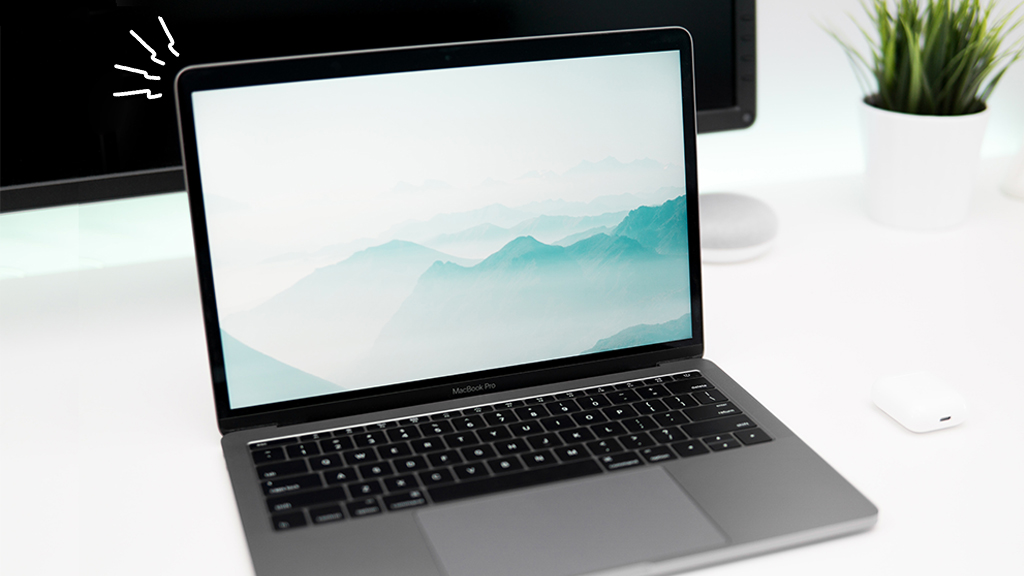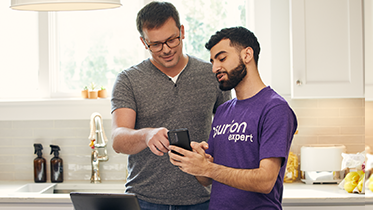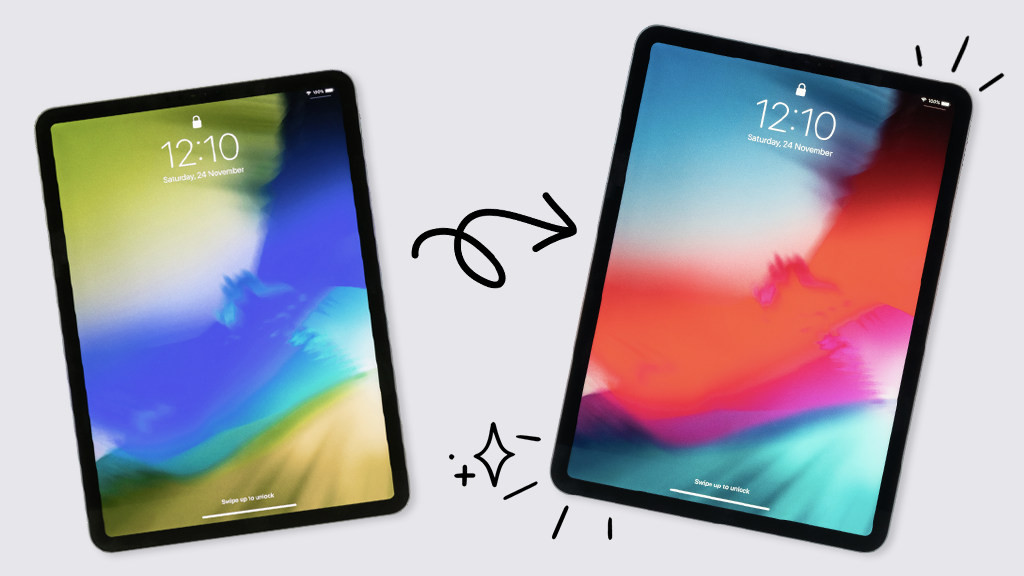If you've ever had a flickering MacBook Pro® screen, you know how easily it can ruin your work day or movie night. Fortunately, there are some simple fixes that can help resolve the problem.
At Asurion, when tech breaks, we fix it—whether your MacBook® won't turn on or it needs a factory reset. We'll walk you through what to do if your MacBook Pro screen is flickering so you can get back to what's important.
What causes a MacBook Pro screen to flicker?
Both physical damage and software problems can cause a flickering MacBook Pro screen. Here are some examples:
- Malware
- Dropping sharp objects onto your laptop
- Dropping it from a high height
- Liquid seeping in and harming the battery
- Software glitches that affect your screen
How to troubleshoot MacBook Pro screen flickering?
There are various ways to try to stop your screen from flickering. Our suggestions go from simple to increasingly more complex, so start at the beginning and work your way down the list.
Restart your MacBook
Sometimes, a simple restart will fix your MacBook screen glitch. Just click on the Apple® logo in the top-left corner, then select Restart.
Check for a software update
Updating your MacBook Pro to the latest iOS® version can solve all kinds of issues, including a flickering screen. Here's how to confirm that your laptop is running the latest version of macOS®.
- Open System Preferences.
- Select Software Update.
- If there's an available update, click Update Now and follow the onscreen instructions.
- Your Mac will restart automatically. When it does, check to see if the blinking has stopped.

You can’t work when your computer doesn’t want to
Get it repaired fast at one of our stores. Just stop in or make an appointment⎯we'll handle the rest.
Disable Dark Mode and True Tone
We're all used to staring at a bright white screen, but Dark Mode offers a darker color scheme that's easier on our eyes. Meanwhile, True Tone technology adjusts the color and intensity of your retina display to match the light around you, so that what you see on your screen appears more natural. Both features can occasionally lead to screen flickering.
To disable Dark Mode:
- Go to the Apple menu > System Preferences, then click General.
- Look at the first category in the new window, called Appearance.
- Select the first option, Light. Your screen will change from dark to light mode.
To disable True Tone:
- Go to the Apple menu > System Preferences, then click Displays. If you have more than one display connected, click Display Settings and then choose your display.
- Click the checkbox to clear it and turn off the True Tone feature.
Remove recently downloaded files, unwanted data, and junk files
Another cause of screen flickering lines on your MacBook Pro? Recently downloaded applications and files, which may have viruses. To erase them from your computer:
- Go to the dock and click on the Finder.
- Locate the file or application you want to delete, then drag it to the trash bin.
- Empty the trash bin.
You can also use the optimization tools found in Storage by opening the Apple menu, clicking Storage > Manage, and choosing from the different options: Store in iCloud, Optimize Storage, Empty Trash Automatically, and Reduce Clutter.
Disable automatic graphics switching
Many MacBooks come with two graphics systems. They also come with the automatic graphics switching option turned on to enable your computer to use the best one for whatever you're doing—and to maximize battery life. But sometimes the two graphics systems can cause screen flickering. To turn off the setting:
- Go to Apple menu > System Preferences > Battery.
- Click the Battery option on the left side of the window.
- You'll see a list of options. Clear the automatic graphics switching checkbox. In macOS Catalina 10.15 and earlier, this setting is in Energy Saver preferences.
If you don't see automatic graphics switching listed, your computer has one graphics system.
Reset NVRAM
If that acronym looks more like a foreign language than a tech term, you're not alone. NVRAM stands for non-volatile random-access memory, which stores different kinds of data, including your screen resolution, volume preferences, and time zone information. Screen flickering can start when the NVRAM is cluttered or outdated. Here's how to reset your NVRAM:
- Shut down your Mac.
- Turn it back on and immediately press and hold Option + Command + P + R for 20 seconds.
- Your MacBook will restart with the NVRAM reset and, hopefully, your flickering screen will be resolved.
Reset SMC
Your MacBook Pro's System Management Controller (SMC) determines how your computer manages power. Much like restarting and updating, resetting the SMC can resolve various glitches, including a flickering screen. There are different ways to reset the SMC, depending on which model you have.
If your MacBook Pro has Apple silicon
Reset the SMC by restarting your computer. There are two ways to check if your computer has Apple silicon:
- Refer to this list of device models from Apple.
- Go to the Apple menu > About This Mac and look to see if a chip is listed. For example, it might say Chip Apple M1.
If your MacBook Pro has a T2 security chip
To find out whether your computer has a T2 security chip, check out this list of device models from Apple, or follow these steps:
- Open the Apple Menu.
- Press and hold Option, then click System Information > Controller.
- Look for the “Apple T2 Security Chip."
If your computer does have the T2 security chip, does, follow these steps:
- Restart your MacBook by going to the Apple menu > Restart.
- As soon as your computer turns on, press Shift+Control±Option on the left side of your built-in keyboard.
- Hold for 10 seconds, then press the Power button and count to 10 again.
- Release all of the keys, wait a moment, then turn on your MacBook.
Restart your MacBook in Safe Mode
Doing so will help you figure out whether the software that loads as your Mac starts up is causing your screen to flicker. Keep in mind, your screen resolution may be low and your computer may run slowly—that's normal in Safe Mode. When you're ready, check our guide to how to start your computer in Safe Mode. If the flickering stops in Safe Mode, turn off your Mac and then turn it back on as usual—you're good to go.
Run Apple Diagnostics
If you've tried the troubleshooting tips above but the screen flickering continues on your MacBook Pro, it's time to run Apple Diagnostics. It will help figure out if there's a hardware issue.
- Shut down your computer.
- Disconnect all external devices except for your mouse, keyboard, display, Ethernet (if you use one), and connection to power.
- If it isn't already, put your computer on a flat, hard surface with good ventilation.
If you're using a Mac with Apple silicon:
- Turn on your computer, continuing to press and hold the Power button as your Mac starts up.
- Release the Power button when you see the startup options window, which includes a gear icon labeled Options.
- Press Command + D on your keyboard.
If your Mac doesn't use Apple silicon:
- Turn on your computer and immediately press and hold the D key.
- Release the D key when the Language Options appear or when you see a progress bar.
In both cases, Apple Diagnostics will run a scan for any problems and identify where a defect may be. You'll receive one or more reference codes, which you can read more about here. From here you can do a few things:
- Repeat the test by clicking “Run the test again" or pressing Command + R.
- Restart your Mac by clicking Restart or pressing R.
- Shut down by clicking Shut Down or pressing S.
If you've tried these steps and still need a little help, we're right around the corner. Schedule a repair at the nearest uBreakiFix® by Asurion store and our certified experts can get your device back up and running as soon as the same day.





